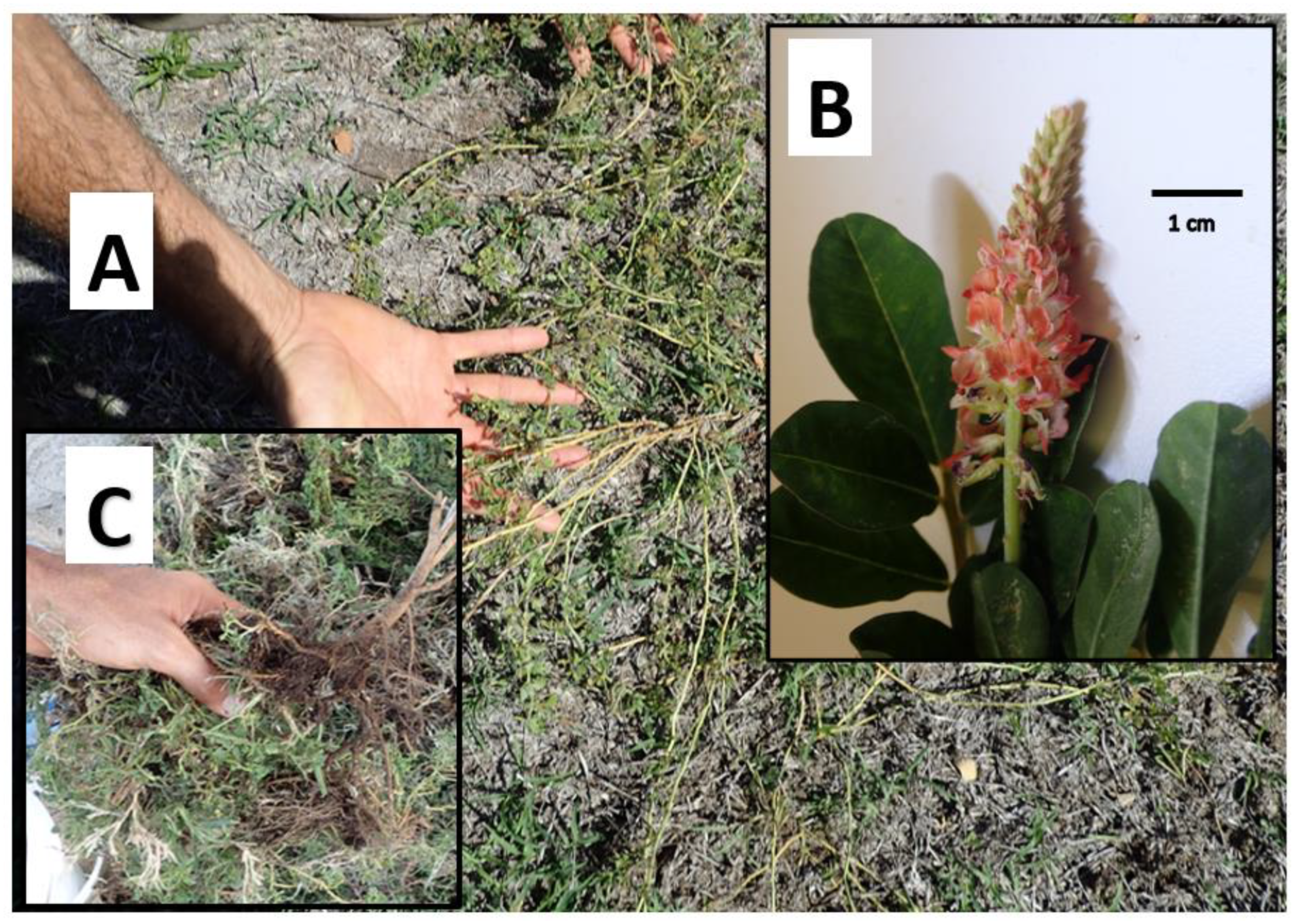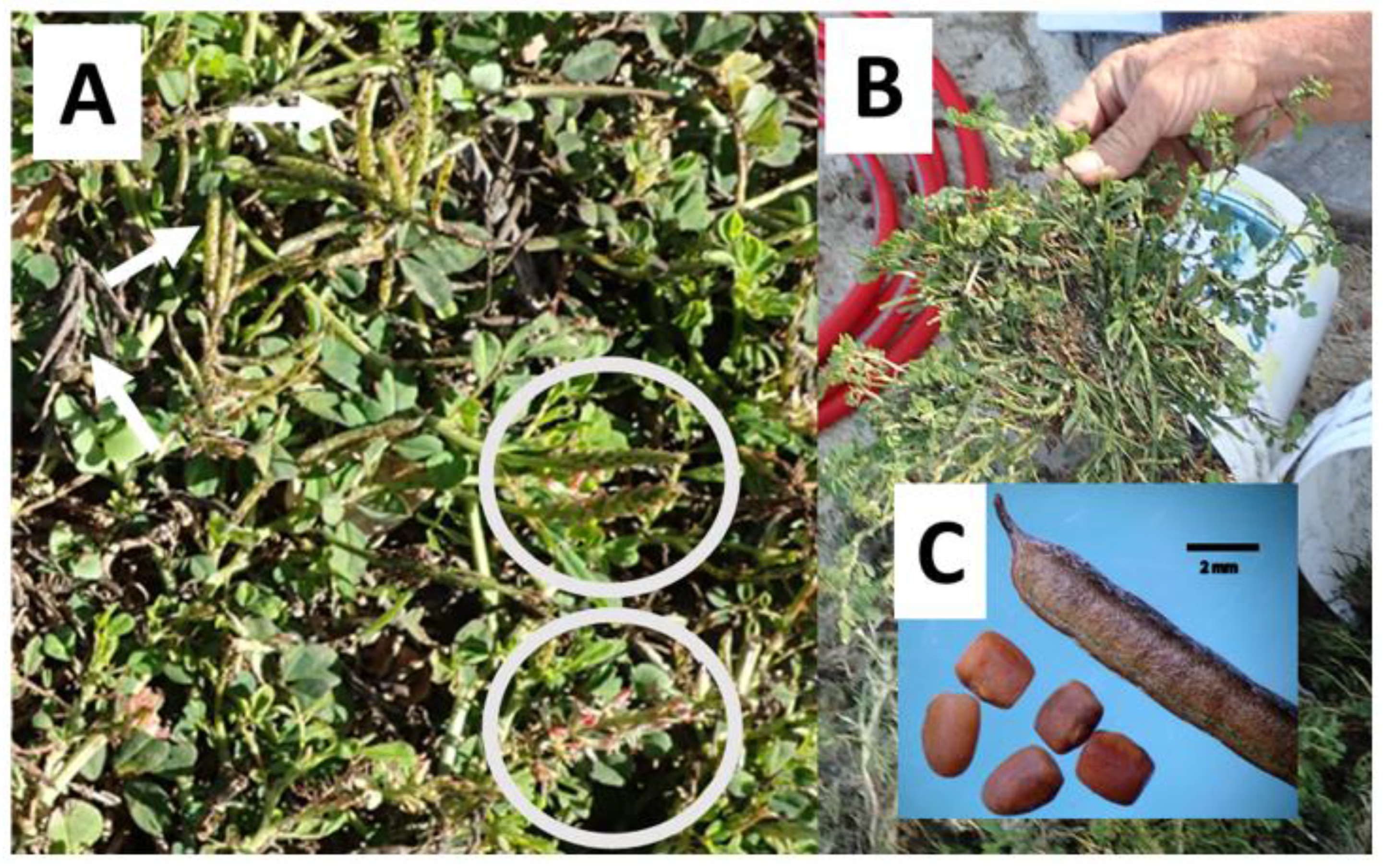Trouble for Horses in Paradise: Toxicity and Fatality Resulting from the Consumption of Indigofera spicata (Fabaceae) on Oahu Island
Abstract
:1. Introduction
1.1. Background
1.2. Plant Identity, Origin, and Distribution
1.3. Symptoms, Toxicity, and Toxic Components
1.4. Signs of Creeping Indigo Toxicity
1.5. Current Records of Toxicity and Fatality on Oahu Island
1.6. Chemical Control
1.7. Treatment and Prevention
2. Discussion
3. Conclusions
Author Contributions
Funding
Institutional Review Board Statement
Informed Consent Statement
Data Availability Statement
Acknowledgments
Conflicts of Interest
References
- CABI. Invasive Species Compendium: Indigofera Spicata (Creeping Indigo); CAB International: Wallingford, UK, 2014; Available online: https://www.cabi.org/isc/datasheet/79262 (accessed on 23 February 2022).
- Wagner, W.L.; Herbst, D.R.; Sohmer, S.H. Manual of the Flowering Plants of Hawaii. Revised Edition Volume 1; Bishop Museum Special Publication; University of Hawaii Press: Honolulu, HI, USA, 1999; Volume 97, p. 988. [Google Scholar]
- HEAR. Pacific Island Ecosystems at Risk (PIER). Indigofera Spicata Forsskal, Fabaceae. 2022. Available online: http://www.hear.org/pier/species/indigofera_spicata.htm (accessed on 2 February 2022).
- Morton, J.F. Creeping indigo (Indigofera spicata Forsk.) (Fabaceae)—A hazard to herbivores in Florida. Econ. Bot. 1989, 43, 314–327. [Google Scholar] [CrossRef]
- Norfeldt, S.; Henke, L.A.; Morita, K.; Matsumoto, H.; Takahashi, M.; Younge, O.R.; Willers, E.; Cross, R.F. Feeding Tests with Indigofera endecaphyla Jacq (Creeping Indigo) and Some Observations on the Poisonous Effects on Domestic Animals; Agricultural Experiment Station Technical Bulletin; University of Hawaii: Honolulu, HI, USA, 1952; Technical Bulletin; 15. [Google Scholar]
- Sellers, B.A.; Carlisle, B.; Wiggins, L. Creeping Indigo: A Small, Yet Lethal Plant; South Florida Beef-Forage Program; IFAS Extension, University of Florida: Gainesville, FL, USA, 2013; p. 3. [Google Scholar]
- Britten, E.J.; Palafox, A.L.; Frodyma, M.M.; Lynd, F.T. Level of 3-nitropropanoic acid in relation to toxicity of Indigofera spicata in chicks. Crop Sci. 1963, 3, 415–416. [Google Scholar] [CrossRef] [Green Version]
- Bendiksen, S.H.; Yazdani, M.; Sandås, E.M.; Østeby, V.A.; Kristensen, E.; Haarr, D.; Rootwelt, H.; Elgstøen, K.B.P. A pioneer study on human 3-nitropropionic acid intoxication: Contributions from metabolomics. J. Appl. Toxicol. 2022, 42, 818–829. [Google Scholar] [CrossRef] [PubMed]
- The Brooke. Animal Health Mucous Membranes. The Working Equid Veterinary Manual; Whittet Books, Essex. 2013, p. 9. Available online: https://www.thebrooke.org/sites/default/files/Animal%20Welfare/Welfare%20Interpretation%20Manual-%20Chapter%202%2C%20MucousMembranes.pdf (accessed on 17 May 2022).
- Hegarty, M.P.; Pound, A.W. Indospicine, a new hepatotoxic amino-acid from Indigofera spicata. Nature 1968, 217, 354–355. [Google Scholar] [CrossRef] [PubMed]
- Fletcher, M.T.; Al Jassim, R.A.; Cawdell-Smith, A.J. The occurrence and toxicity of Indospicine to grazing animals. Agriculture 2015, 5, 427–440. [Google Scholar] [CrossRef] [Green Version]
- Anderson, R.C.; Majak, W.; Rassmussen, M.A.; Callaway, T.R.; Beier, R.C.; Nisbet, D.J.; Allison, M.J. Toxicity and metabolism of the conjugates of 3-nitropropanol and 3-nitropropionic acid in forages poisonous to livestock. J. Agric. Food Chem. 2005, 53, 2344–2350. [Google Scholar] [CrossRef] [PubMed]
- Younge, O.R.; Willers, E.H.; Cross, R.F. Feeding tests with Indigofera endecaphylla Jacq. (creeping indigo) and some observations on its poisonous effects on domestic animals. Hawaii Agric. Exp. Sta. Tech. Bull. 1952, 15, 23. [Google Scholar]
- MacKay, R. Large Animal Medicine UF 2014. Creeping Indigo Toxicity. Large Animal Hospital. College of Veterinary Medicine, University of Florida. 2014. Available online: https://largeanimal.vethospitals.ufl.edu/hospital-services/internal-medicine/creeping-indigo-toxicity/ (accessed on 29 October 2021).
- Ossedryver, S.M.; Baldwin, G.I.; Stone, B.M.; McKenzie, R.A.; van Eps, A.W.; Murray, S.; Fletcher, M.T. Indigofera spicata (creeping indigo) poisoning of three ponies. Aust. Vet. J. 2013, 91, 143–149. [Google Scholar] [CrossRef] [PubMed]
- Weaver, E. What’s Creeping Through Your Pasture? Brandon Equine Medical Center. 2022. Available online: http://brandonequine.com/publications.php (accessed on 8 February 2022).
- CORTEVA.US. GrazonNextHL-FactSheet. 2022. Available online: https://www.corteva.us/products-and-solutions/pasture-management/grazonnext-hl.html (accessed on 12 February 2022).
- Red River Specialties, Grazon-PD. 2022. Available online: https://rrsi.com/product/grazon-pd/ (accessed on 12 February 2022).
- Kelley, D.E.; Warren, L.K.; Mortensen, C.J. Orally supplemented L-arginine impairs amino acid absorption depending on dose in horses. J. Anim. Sci. 2014, 92, 5560–5566. [Google Scholar] [CrossRef] [PubMed] [Green Version]
- Advanced Equine Dentistry Inc. Creeping Indigo. 2022. Available online: https://advancedequinedentist.com/2020/11/06/creeping-indigo/ (accessed on 12 February 2022).
- Aylward, J.H.; Court, R.D.; Haydock, K.P.; Strickland, R.W.; Hegarty, M.P. Indigofera species with agronomic potential in the tropics. Rat toxicity studies. Aust. J. Agric. Res. 1987, 38, 177–186. [Google Scholar] [CrossRef]
- Hassen, A. Characterization and Evaluation of Indigofera Species as Potential Forage and Cover Crops for Semi-Arid and Arid Ecosystems. Ph.D. Thesis, University of Pretoria, Pretoria, South Africa, 2006; p. 198. [Google Scholar]
- Du Puy, D.J.; Labat, J.N.; Schrire, B.D. The separation of two previously confused species in the Indigofera spicata complex (Leguminosae: Papilionoideae). Kew Bull. 1993, 48, 727–733. [Google Scholar] [CrossRef]
- Heuzé, V.; Tran, G.; Maxin, G.; Lebas, F. Creeping Indigo (Indigofera spicata and Indigofera hendecaphylla). Feedipedia, a Programme by INRAE, CIRAD, AFZ and FAO. 2016. Available online: https://www.feedipedia.org/node/286 (accessed on 8 February 2022).
- Bulle, F.; Mavier, P.; Zafrani, E.S.; Preaux, A.M.; Lescs, M.C.; Siegrist, S.; Dhumeaux, D.; Guellaën, G. Mechanism of gamma-glutamyl transpeptidase release in serum during intrahepatic and extrahepatic cholestasis in the rat: A histochemical, biochemical and molecular approach. Hepatology 1990, 11, 545–550. [Google Scholar] [CrossRef] [PubMed]
- Mann, S.; Ramsay, J.D.; Wakshlag, J.J.; Stokol, T.; Reed, S.; Divers, T.J. Investigating the pathogenesis of high-serum gamma-glutamyl transferase activity in Thoroughbred racehorses: A series of case-control studies. Equine Vet. J. 2021, 54, 13435. [Google Scholar] [CrossRef] [PubMed]
- Ramadan, M.M.; Murai, K.T.; Johnson, T. Host range of Secusio extensa (Lepidoptera: Arctiidae), and potential for biological control of Senecio madagascariensis (Asteraceae). J. Appl. Entomol. 2010, 135, 269–284. [Google Scholar] [CrossRef]
- Hembrough, A.M.; Borowicz, V.A. Pre-dispersal seed predation by the weevils Trichapion rostrum and Tychius sordidus limits reproductive output of Baptisia alba (Fabaceae). Botany 2017, 95, 809–817. [Google Scholar] [CrossRef]



| Date and Hour | Symptoms | Treatment | Notes |
|---|---|---|---|
| 18 November 2020 10:23 a.m. | Stopped eating last night | 7 ounces of molasses (198 g) | |
| 19 November 2020 12:22 a.m. | Breathing heavily, dehydrated Fever 105.3 | 2 ounces of molasses (56 g) | |
| 12:49 a.m. | Pulse 92.0 | ||
| 1:15 a.m. | Pulse 104.7 | 10 cc Banamine 4 g Bute | Equine ice boots on, pacing |
| 1:36 a.m. | Pulse 104.9 | ||
| 1:58 a.m. | Pulse 102.9 | ||
| 2:30 a.m. | Pulse 105.0 | ||
| 3:27 a.m. | Pulse 98.5 | After hosing and icing for 15–20 min. |
| Horse | Date (m/d/y) | 1 GGT (IU/L) Enzyme Level |
|---|---|---|
| Brutus | 1 November 2021 | 28 |
| Haole Girl | 1 November 2021 | WNL |
| Truco | 19 October 2021 | 56 |
| “ | 18 September 2021 | 22 |
| Molly | 19 October 2021 | 116 |
| “ | 13 March 2021 | WNL |
| Mia | 19 October 2021 | WNL |
| Jackson | 19 October 2021 | 23 |
| “ | 29 June 2021 | WNL |
| “ | 13 March 2021 | WNL |
| John Wayne | 15 October 2021 | 239 |
| Rincon | 24 August 2021 | 203 |
| “ | 12 July 2021 | 259 |
| “ | 8 June 2021 | 104 |
| “ | 6 March 2021 | 238 |
| Bingo | 21 May 2021 | 121 |
| Siracha | 5 April 2021 | 25 |
| “ | 9 November 2021 | WNL |
| Hoagi | 19 March 2021 | WNL |
| Holly | 13 March 2021 | WNL |
| Cali | 9 November 2021 | WNL |
| “ | 13 March 2021 | 41 |
| Blueberry | 13 March 2021 | WNL |
| Kupaa | 5 January 2021 | 46 |
| “ | 22 December 2020 | 56 |
| “ | 27 December 2020 | WNL |
| Pia | 22 December 2020 | WNL |
| Serena * | 17 November 2020 | 131 |
| “ | 7 November 2020 | 155 |
| Tomahawk | 9 November 2021 | WNL |
| Apollo | 9 November 2021 | WNL |
| Anty Up | 9 November 2021 | WNL |
Publisher’s Note: MDPI stays neutral with regard to jurisdictional claims in published maps and institutional affiliations. |
© 2022 by the authors. Licensee MDPI, Basel, Switzerland. This article is an open access article distributed under the terms and conditions of the Creative Commons Attribution (CC BY) license (https://creativecommons.org/licenses/by/4.0/).
Share and Cite
Ramadan, M.M.; Dailey, D. Trouble for Horses in Paradise: Toxicity and Fatality Resulting from the Consumption of Indigofera spicata (Fabaceae) on Oahu Island. Vet. Sci. 2022, 9, 271. https://doi.org/10.3390/vetsci9060271
Ramadan MM, Dailey D. Trouble for Horses in Paradise: Toxicity and Fatality Resulting from the Consumption of Indigofera spicata (Fabaceae) on Oahu Island. Veterinary Sciences. 2022; 9(6):271. https://doi.org/10.3390/vetsci9060271
Chicago/Turabian StyleRamadan, Mohsen Mohamad, and Devon Dailey. 2022. "Trouble for Horses in Paradise: Toxicity and Fatality Resulting from the Consumption of Indigofera spicata (Fabaceae) on Oahu Island" Veterinary Sciences 9, no. 6: 271. https://doi.org/10.3390/vetsci9060271
APA StyleRamadan, M. M., & Dailey, D. (2022). Trouble for Horses in Paradise: Toxicity and Fatality Resulting from the Consumption of Indigofera spicata (Fabaceae) on Oahu Island. Veterinary Sciences, 9(6), 271. https://doi.org/10.3390/vetsci9060271





